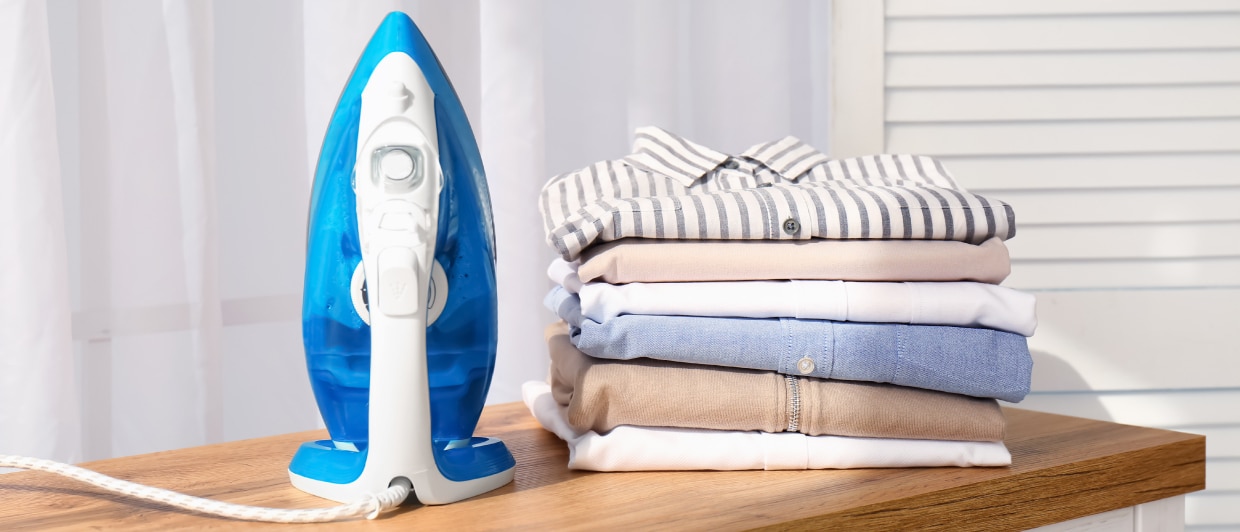

2025 Popular Iron Shopping Guide & Recommendation
Main types of irons
1. Steam irons
How it works: Clothes are ironed and smoothed by physically pressing with steam and a heated soleplate.
Advantages: The effect from a steam iron is very evident.
Fabric type: Suitable for ironing clothes for formal occasions such as business suits, student uniforms, shirts etc.
2. Vertical steamer
How it works: Steam is used to soften the surface of clothes while at the same time pulling and smoothing the fabric to make the wrinkles disappear.
Advantages: No ironing board is needed and the damage to clothes from the vertical steamers is minimal. Clothes are ironed easily under the action of double gravity. Many vertical steamers are equipped with high-temperature steam and sterilization functions to remove bacteria for more satisfactory results.
Fabric type: Great for ironing knitwear and sweaters for better results that with traditional irons. Vertical steamers can also be used to iron bedding, curtains and other household items that are difficult to iron directly.
3. Pressure steam irons
How it works: Clothes are ironed and smoothed with physical pressure using high-pressure steam and heated soleplate.
Advantages: Pressure steam irons generate up to 2 times the steam volume of general steam irons to effectively increase the ironing speed.
Fabric type: Jeans and even silk clothes can be ironed easily. Pressure steam irons can also handle heavy and complicated clothing.
4. Steam brush
How it works: Steam penetrates through the fibers in clothes to loosen them for a smoothing effect.
Advantages: Use horizontally or vertically for a superb ironing result. Design of this type of iron is lighter and compact making it convenient to use at any time and anywhere.
Fabric type: Good for extra fine fabrics and even areas that are difficult to iron with general irons.
Hot brands: Philips , Bruno , GERMAN POOL , NOVEL
Hot products: PHILIPS GC810/26 8000 Series 2-in 1 Handheld Garment Steamer, Bruno BOE076 Styling Handy Steamer, PHILIPS GC3929/66 Steam iron, GERMAN POOL IRH112 Handheld Garment Steamer
Things to consider when shopping for an iron
1. Arrangement of steam holes on the soleplate
There are two kinds of soleplate designs: half-row and full-row steam hole. The half-row design is where the steam holes are arranged in the front half of the soleplate. The full row refers to steam holes that surround the entire soleplate. The full-row design releases a larger amount of steam so choose a steam iron according to your desired steaming result.
2. Soleplate material
Irons with a cast iron base are harder, not easy to scratch and the heat transfer performance fulfills most general uses. Irons with an aluminum alloy base offer better heat transfer and faster heating speed. Irons that come with ceramic soleplates slide more smoothly with less friction on clothes during ironing.
3. Soleplate shape
Comes either with two pointed ends or one pointed end and the other a round end to avoid wrinkles on clothes during back and forth ironing.
4. Additional functions
The main function of an iron is to remove wrinkles, but other additional functions you can consider include an auto shutdown, sterilization function and multiple temperature settings to make ironing less of a chore.
5. Cordless or cord design
Cordless or portable design: As the iron and base are composed of two parts, you can use it without dragging the power cord during ironing. Simply return the iron onto the base for charging. A cordless compact iron makes ironing handy when you travel.
Cord design:Pick an iron that comes with a cord if you do ironing frequently at home.
6. Iron size
Besides the size of the main body of the iron, consider the size of the accessories. Make use of these if you have sufficient space in your cabinet at home to store the iron and accompanying accessories.
Iron Q&A
1. Can the same temperature be applied on different fabrics?
Different fabrics require different ironing temperatures. Before ironing a piece of clothing, check to see if the material is suitable for ironing and the maximum temperature it can withstand. Do not use too high a temperature to iron clothes. Generally speaking, the thicker the clothes, the higher the temperature needed while thin and more delicate clothes require a lower ironing temperature. Note that thin clothes such as silk, nylon, etc. should not be steamed ironed but should be dry or hang ironed.
2. What should I do with the residue water in the tank after ironing?
After using the steam iron or the vertical steamer, pour out the remaining water and allow the residual heat of the appliance to let the water inside evaporate. The vertical steamer should be cooled down completely before storing away. This prevents the breeding of bacteria, the generation of scale or odour from water left inside the appliance.

